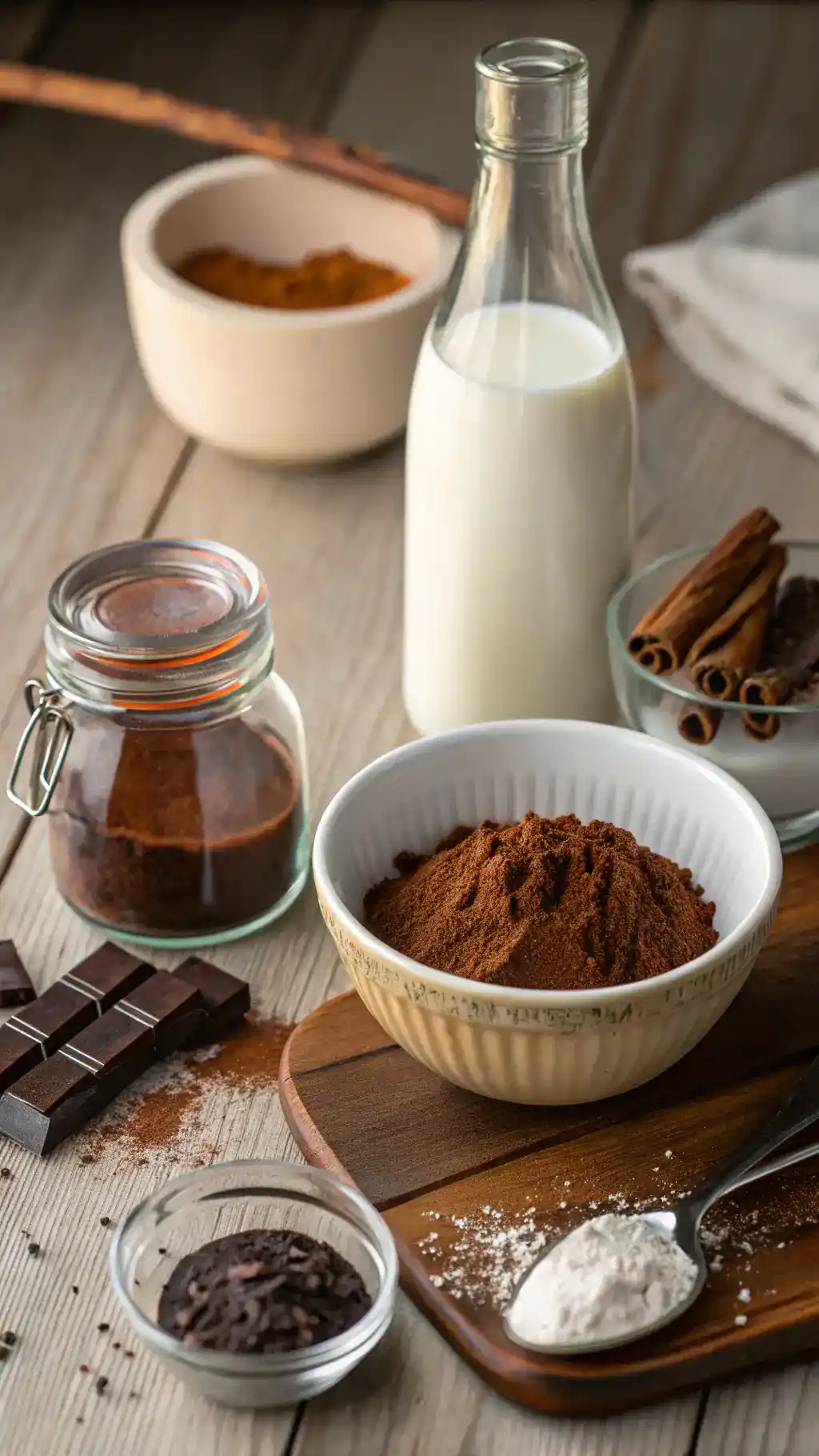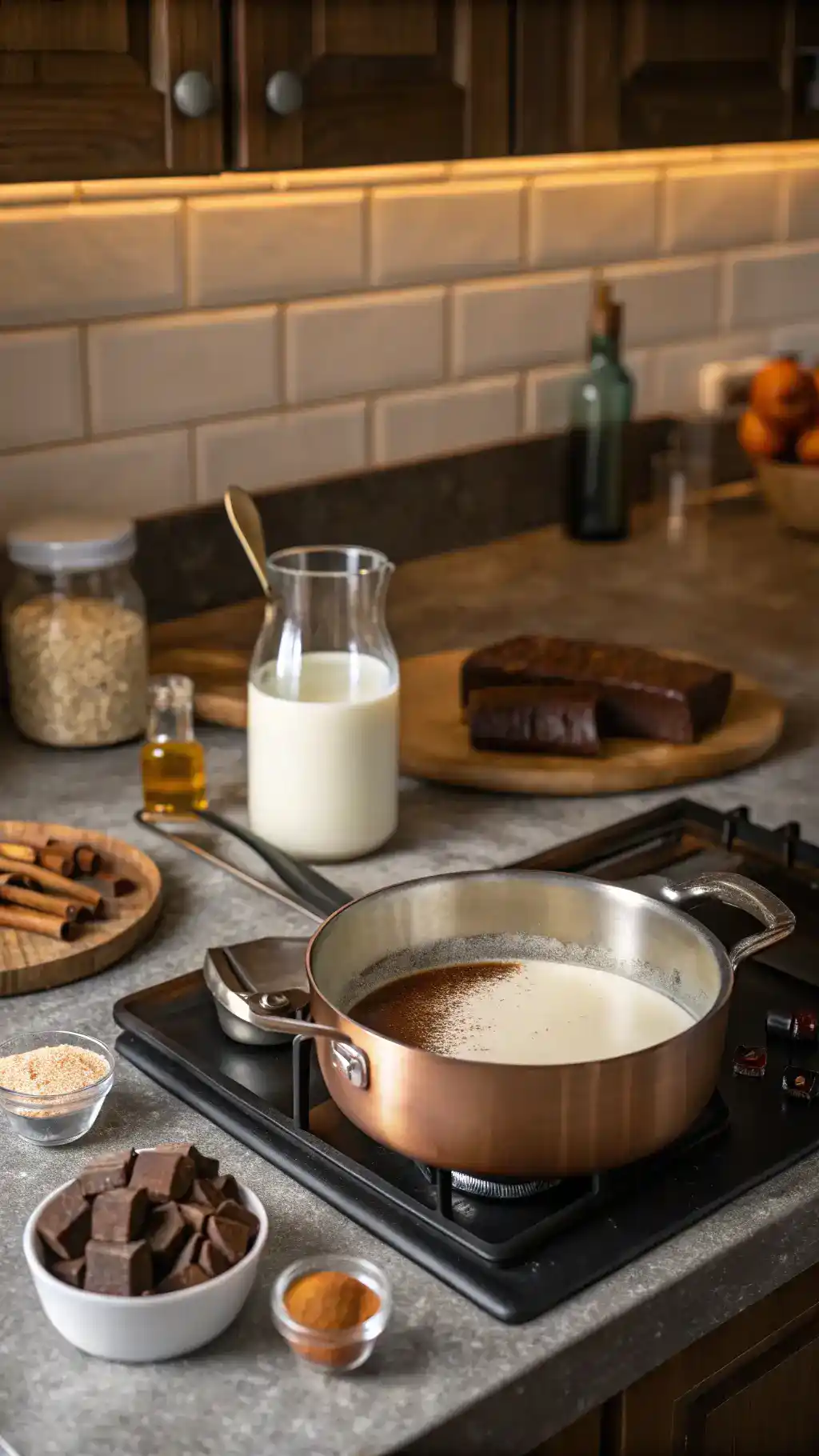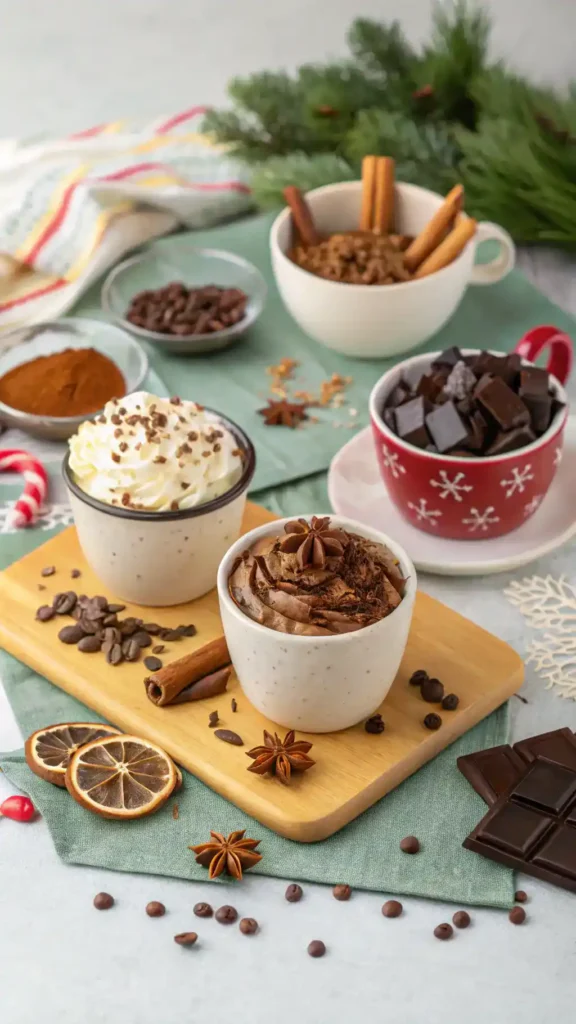There’s nothing quite like a steaming cup of homemade hot chocolate to lift your spirits on a chilly day, is there? Whether you’re indulging in the rich, creamy goodness of the classic recipe or adding your own twist with creative variations, this homemade hot chocolate will quickly become your go-to comfort drink. The best part? You can customize it to your exact taste, from choosing dairy-free alternatives to adding a dash of cinnamon or even a shot of espresso for a mocha twist. With just a few simple ingredients, you can create a cup of hot chocolate that’s not only delicious but also free from the preservatives and artificial additives often found in store-bought mixes. Ready to warm up with a cup of indulgence? Let’s dive into this easy, step-by-step guide to making the best homemade hot chocolate!
Table of Contents
Key Benefits of Homemade Hot Chocolate
Making homemade hot chocolate isn’t just about indulging in a delicious treat—it’s also about enjoying a drink that’s customizable, comforting, and packed with benefits. Here’s why you should skip the pre-made mixes and whip up a batch from scratch:
- Nutritional Control: When you make hot chocolate at home, you have complete control over the ingredients. You can choose organic cocoa, natural sweeteners like honey or maple syrup, and even plant-based milks like almond or oat milk. This ensures that you’re sipping on a cleaner, healthier version without any preservatives or artificial additives.
- Rich, Authentic Flavor: Homemade hot chocolate has a depth of flavor that store-bought versions simply can’t match. With real cocoa powder or melted chocolate, you’ll get a velvety, indulgent texture and a deep, rich taste that will make every sip feel like a treat.
- Customization for Any Diet: Whether you’re following a vegan, dairy-free, or gluten-free diet, homemade hot chocolate is a versatile drink that can easily accommodate your needs. Swap out the milk for your favorite dairy-free alternative, like coconut or almond milk, and use natural sweeteners to create a version that fits your dietary preferences.
- Indulgent but Guilt-Free: By using high-quality ingredients and adjusting sweetness levels to your liking, you can create a version that’s just as indulgent as the store-bought kind, but with fewer calories and no artificial ingredients. For a lighter version, you can opt for a lower-calorie milk, such as almond milk, and adjust the sweetness with stevia or other healthier alternatives.
- Simple, Yet Rewarding: There’s something deeply satisfying about making hot chocolate from scratch. With just a few basic ingredients, you can create a warm, comforting beverage that’s perfect for cozy moments or sharing with loved ones. Plus, it’s a fun, easy recipe to make with kids or friends when you need a simple activity to enjoy together.
So, whether you’re looking for a cozy treat on a cold day or a healthier twist on a classic, homemade hot chocolate is a win in every way. Ready to try making your own? Let’s move on to the ingredients you’ll need!
Ingredients for Homemade Hot Chocolate
To make the perfect homemade hot chocolate, all you need is a few simple ingredients that come together to create a rich, creamy, and indulgent drink. Whether you’re a chocolate connoisseur or just in the mood for a cozy treat, here’s everything you’ll need to get started:

Ingredients:
- 2 tablespoons unsweetened cocoa powder – This is the star ingredient that gives your hot chocolate its deep chocolate flavor. You can choose between natural cocoa powder, which has a more robust taste, or Dutch-processed cocoa powder for a smoother, milder drink. Whichever you choose, make sure to sift it before mixing to avoid clumps.
- 2 tablespoons sugar – Sugar balances out the bitterness of the cocoa. You can use white granulated sugar for a classic taste, or swap it for natural sweeteners like maple syrup, honey, or coconut sugar for a healthier twist. Feel free to adjust the amount based on how sweet you like your hot chocolate.
- 2 cups milk – Whole milk is ideal for a creamy, rich texture. However, if you’re following a dairy-free or vegan diet, you can substitute with almond milk, oat milk, or coconut milk. Each alternative will bring its unique flavor and creaminess, so don’t be afraid to experiment with what you like best.
- 1/4 teaspoon vanilla extract – This small addition can make a big difference in enhancing the flavor. The vanilla extract adds a subtle sweetness and aroma that takes your hot chocolate to the next level.
- Pinch of salt – A small pinch of salt is essential to balance out the sweetness and enhance the depth of the chocolate flavor. It also prevents the drink from tasting flat.
- 1/2 cup water – Water is needed to help dissolve the cocoa powder and sugar before you add the milk. It also creates a smoother consistency and ensures that your hot chocolate isn’t too thick.
Substitutions and Alternatives:
- For Dairy-Free & Vegan Options: You can easily make your hot chocolate dairy-free by using almond milk, oat milk, or soy milk instead of cow’s milk. These alternatives also bring their own subtle flavors to the drink. For a creamier consistency, try coconut milk.
- For Low-Sugar or Sugar-Free Versions: If you’re cutting down on sugar, opt for a natural sweetener like stevia or monk fruit. You can also use a sugar substitute like erythritol for a more calorie-friendly version without compromising flavor.
- For a Richer Chocolate Flavor: To make the hot chocolate extra decadent, you can add a handful of chocolate chips or a couple of squares of your favorite dark chocolate. Let it melt into the milk for a smooth, ultra-chocolaty taste.
Once you’ve gathered all your ingredients, you’re ready to move on to the fun part—making your hot chocolate from scratch! Trust me, it’s going to be delicious.
How to Make Homemade Hot Chocolate
Making homemade hot chocolate is a simple yet rewarding process. With just a few easy steps, you can have a creamy, rich drink that’s far better than anything you can find in a store. Let’s walk through the process together, step by step, so you can enjoy the perfect cup of hot chocolate.

Step-by-Step Instructions:
- Mix the Dry Ingredients
- In a small saucepan, combine 2 tablespoons of cocoa powder, 2 tablespoons of sugar, and a pinch of salt. Use a whisk to blend the ingredients well. Sifting the cocoa powder first can help prevent any lumps, ensuring a smooth texture.
- Add Water and Heat
- Pour 1/2 cup of water into the dry mixture. Stir gently to create a paste, ensuring there are no dry spots. Place the saucepan over medium heat and continue stirring as the mixture begins to warm. Heat it until it’s just hot, but not boiling—this helps dissolve the cocoa powder and sugar evenly.
- Add Milk
- Once the cocoa mixture is warm, pour in 2 cups of milk (or your chosen dairy-free alternative). Stir constantly to blend the milk with the cocoa mixture. Keep the heat on medium-low, and ensure the milk doesn’t come to a boil. Stir occasionally to avoid the milk forming a skin on top or sticking to the bottom of the pan.
- Stir in Vanilla
- When your hot chocolate is heated through and smooth, remove the saucepan from the heat. Add 1/4 teaspoon of vanilla extract. Stir to combine, giving your hot chocolate that wonderful, aromatic sweetness. Taste it, and if you’d like it sweeter, feel free to add a bit more sugar or your preferred sweetener.
- Serve and Enjoy
- Pour your hot chocolate into a mug. If you’re feeling indulgent, top it off with whipped cream, marshmallows, or chocolate shavings for extra richness. For a fun twist, you could even sprinkle a little cinnamon or nutmeg on top for a spiced flavor.
Tips for a Perfect Hot Chocolate:
- Don’t Boil the Milk: Always heat the milk gently over medium-low heat. Boiling it can cause it to curdle or develop an unpleasant skin. Heating it slowly ensures a smooth, creamy texture.
- Stir Continuously: To avoid lumps, make sure to whisk the cocoa and sugar mixture thoroughly before adding the milk. Stir constantly while heating to keep everything blended and smooth.
- Adjust the Sweetness: Everyone’s taste is different! Don’t hesitate to adjust the amount of sugar or sweetener depending on how sweet you like your hot chocolate. Start with a small amount and taste-test as you go.
- Make it Extra Rich: For a truly indulgent hot chocolate, add a few squares of high-quality chocolate or a handful of chocolate chips to the mixture. Let them melt into the milk for an even richer flavor.
Now that you’ve mastered the basic method for making homemade hot chocolate, you can feel free to experiment with variations and flavors that suit your mood. Get ready to enjoy the most delicious, cozy drink you’ve ever had!
Pro Tips and Variations
Now that you’ve learned how to make homemade hot chocolate, let’s take it up a notch with some expert tips and creative variations. Whether you’re looking to make it healthier, spicier, or more decadent, these ideas will help you customize your hot chocolate to suit your taste.

Pro Tips for the Best Hot Chocolate:
- Use High-Quality Cocoa: The better the cocoa, the better your hot chocolate will taste. Look for high-quality, unsweetened cocoa powder or even chocolate bars you can melt into the drink. Organic cocoa or single-origin varieties will give you a richer, deeper flavor.
- Heat the Milk Slowly: When heating milk, do it over medium or low heat. This helps prevent the milk from scorching, which can make it taste burnt or alter its creamy texture.
- Whisk for Smoothness: Use a whisk to stir the cocoa and sugar mixture into the milk. This ensures a smooth, lump-free texture. If you notice any lumps, keep whisking or use a fine mesh strainer to remove them.
- Make it Extra Creamy: For a richer texture, replace part of the milk with heavy cream or full-fat coconut milk. This will give your hot chocolate an ultra-creamy mouthfeel that’s perfect for a luxurious treat.
- Adjust Sweetness to Taste: Sweetness levels vary from person to person, so start with a little sugar and taste-test as you go. If you prefer a sugar-free version, try natural sweeteners like stevia, monk fruit, or maple syrup.
Creative Variations to Try:
- Peppermint Hot Chocolate: For a festive twist, add a few drops of peppermint extract or top with crushed candy canes. This adds a refreshing, minty flavor that pairs wonderfully with the rich chocolate.
- Mexican Hot Chocolate: Stir in a pinch of cinnamon and a dash of cayenne pepper for a spicy kick. This variation adds warmth and complexity, perfect for chilly nights.
- Mocha Hot Chocolate: If you’re a coffee lover, add a shot of espresso or strong brewed coffee to your hot chocolate. This creates a delightful mocha flavor that combines the best of both worlds.
- Nutty Hot Chocolate: For a nutty, creamy variation, try adding a spoonful of almond butter or hazelnut spread to your hot chocolate. The nutty flavor will pair perfectly with the richness of the chocolate.
- Caramel Hot Chocolate: Swirl in some caramel sauce or add a few pieces of caramel candy for a sweet, buttery touch. This is a decadent, indulgent treat that will satisfy your sweet tooth.
Toppings to Elevate Your Hot Chocolate:
- Whipped Cream: This classic topping adds a light, fluffy texture and extra creaminess. For an added flair, try flavored whipped cream, such as vanilla or chocolate.
- Marshmallows: Mini marshmallows are a fun and nostalgic topping, or for a gourmet touch, toast some larger marshmallows for a smoky flavor.
- Chocolate Shavings: For a little extra decadence, grate some dark chocolate and sprinkle it on top. The chocolate will melt slightly, adding to the richness.
- Crushed Cookies or Biscotti: If you’re in the mood for a treat to dip, crushed cookies like Oreos or a crunchy biscotti will elevate your hot chocolate experience.
With these pro tips and creative variations, you can take your homemade hot chocolate to new heights. Whether you’re in the mood for something simple and classic or want to get experimental with new flavors, there’s always a fun way to make this drink your own. So, don’t hesitate to get creative and tailor your hot chocolate to match your mood or the season!
Serving Suggestions
Now that you’ve mastered making the perfect homemade hot chocolate, it’s time to think about how to serve it. The way you present and pair your hot chocolate can really elevate the experience. Whether you’re enjoying it by yourself or sharing it with friends, here are some ideas to make your hot chocolate even more special.
Perfect Pairings with Hot Chocolate:
- Classic Cookies: Hot chocolate and cookies go together like peanut butter and jelly. Chocolate chip cookies, shortbread, or gingerbread are perfect choices. The sweetness of the cookies complements the richness of the chocolate, making every bite a treat.
- Flaky Pastries: If you’re in the mood for something a little fancier, pastries like croissants or scones make a great pairing. Their light, buttery texture contrasts nicely with the creamy, thick hot chocolate.
- Breakfast Bites: Hot chocolate is also a great way to start the day. Pair it with pancakes or waffles for a decadent breakfast. Add fresh fruit or whipped cream for extra sweetness, and you’ve got a treat that feels like a special occasion.
- Chocolate-Dipped Fruits: For a healthier (but still indulgent) option, serve your hot chocolate with chocolate-dipped strawberries or sliced bananas. The combination of fresh fruit and rich chocolate is a perfect balance of flavors.
Creative Hot Chocolate Presentations:
- Hot Chocolate Bar: If you’re hosting a gathering, why not set up a DIY hot chocolate bar? Lay out different toppings and mix-ins, like whipped cream, marshmallows, chocolate chips, caramel sauce, and cinnamon. Let everyone customize their drink to suit their taste—it’s a fun way to get everyone involved and add a bit of excitement to the experience.
- Mug Presentation: The mug you serve your hot chocolate in can make a difference too. For a cozy, rustic feel, use a large, wide mug. If you’re feeling fancy, opt for a mug with a unique design or add a festive touch with a sprinkle of cinnamon or chocolate shavings on top.
- Garnish with Style: A simple garnish can make your hot chocolate look even more enticing. Top your drink with a dollop of whipped cream, a few marshmallows, and a drizzle of chocolate or caramel sauce. For a seasonal twist, add a sprinkle of crushed candy canes or a cinnamon stick for stirring.
For a Complete Meal:
- Serve with a Sweet Snack: For a satisfying snack to go with your hot chocolate, consider serving it with chocolate-covered nuts or a tray of sweet pastries. You could even add some cheese and crackers if you’re in the mood for a savory option to balance out the richness of the hot chocolate.
- Pair with a Beverage: Hot chocolate is also delicious when paired with coffee or a cup of spiced tea. If you’re having friends over, consider serving hot chocolate as part of a beverage lineup—nothing makes a chilly evening more inviting than a selection of warm drinks.
No matter how you choose to serve your hot chocolate, these thoughtful pairings and creative presentations will take your drink from great to unforgettable. Enjoy the experience as much as the flavor!
Common Problems and Solutions
While making homemade hot chocolate is simple, there are a few common issues that can arise during the process. Don’t worry, though—each of these problems has a quick and easy fix! Here’s a guide to help you troubleshoot and ensure your hot chocolate turns out perfectly every time.
Problem 1: Lumpy Hot Chocolate
- Solution: Lumps often form when cocoa powder doesn’t fully dissolve in the liquid. To avoid this, always sift the cocoa powder before adding it to your sugar mixture. If lumps do appear, use a whisk to vigorously stir the drink as it heats. If lumps persist, strain the mixture through a fine mesh sieve or blend with an immersion blender for a smooth finish.
Problem 2: Hot Chocolate is Too Bitter
- Solution: If your hot chocolate tastes too bitter, it may be due to the cocoa powder or the balance of sweeteners. Start by adding a little more sugar or honey to balance the bitterness. You can also try a pinch of salt, which helps round out the flavor and enhance the sweetness. If you prefer a sweeter taste, you can also experiment with natural sweeteners like maple syrup or agave for a milder sweetness.
Problem 3: Hot Chocolate is Too Thin
- Solution: If your hot chocolate isn’t as thick as you’d like, it could be due to the type of milk you’re using or the ratio of cocoa to liquid. Try using whole milk or a creamy alternative like coconut milk for a thicker, richer drink. If you’re using plant-based milk, choose a version with a higher fat content, such as oat milk. Additionally, you can stir in a spoonful of heavy cream or a few extra pieces of chocolate to boost the richness and create a thicker consistency.
Problem 4: Milk Curdling or Scorching
- Solution: If your milk curdles or scorches, it’s likely due to overheating. Always heat the milk on medium or low heat, and stir it frequently to ensure it heats evenly. If you’re using a stovetop, keep an eye on the milk and remove it from the heat before it reaches boiling point. If you’re using a microwave, heat the milk in short intervals, stirring between each one.
Problem 5: Skin Forms on Top
- Solution: To prevent a skin from forming on your hot chocolate, stir it often while heating. The skin forms when the milk proteins start to settle on the surface. Cover the saucepan with a lid while heating, or transfer the hot chocolate into a mug immediately after heating to prevent the skin from forming.
Problem 6: Hot Chocolate is Too Thin After Storing
- Solution: If you have leftover hot chocolate that’s become too thin after storing, simply reheat it gently on the stove and add a splash of milk or cream to bring back its creamy texture. Stir well to re-incorporate any solids that may have separated while cooling.
By knowing how to handle these common hot chocolate hiccups, you can easily troubleshoot and make sure your homemade hot chocolate always comes out smooth, rich, and indulgent. Now that you’re prepared for anything, enjoy the process of creating the perfect cup every time!
Conclusion
Homemade hot chocolate is more than just a drink—it’s a comforting experience that brings warmth and indulgence, especially on those chilly days when you need something to lift your spirits. By following these simple steps, you can easily make the best hot chocolate from scratch, with the freedom to adjust sweetness, flavor, and texture to your exact liking. Whether you prefer it rich and creamy, spiced with cinnamon, or topped with marshmallows, this recipe is completely customizable to suit your taste.
Now that you have all the tips and tricks to make the perfect homemade hot chocolate, I encourage you to get creative! Try different variations, experiment with toppings, and enjoy the process of crafting your own personalized cup of chocolatey goodness. The best part? No more worrying about artificial additives or preservatives, as you control every ingredient.
So, what are you waiting for? Grab your cocoa powder, pour a cup of milk, and create a warm, delicious treat that will make your day just a little bit sweeter. Don’t forget to share your variations and experiences—whether it’s a classic cup or a spiced-up twist, we’d love to hear how your homemade hot chocolate turns out! Happy sipping!
FAQs
Here are some frequently asked questions to help you get the most out of your homemade hot chocolate recipe. Whether you’re looking for ways to store leftovers or curious about creative variations, we’ve got you covered!
Can I freeze homemade hot chocolate?
Yes! You can freeze leftover hot chocolate to enjoy later. Just let it cool completely, then transfer it to an airtight container or freezer-safe bag. When you’re ready to drink it, defrost it in the fridge overnight and reheat on the stove. For extra creaminess, add a splash of milk while reheating.
Can I make hot chocolate ahead of time for a party?
Absolutely! To make things easier for a party, prepare the hot chocolate in advance and store it in the fridge. Just reheat it on the stove or in a slow cooker when you’re ready to serve. This is a great way to keep the party going without the need to make fresh batches during the event.
What if I don’t have cocoa powder?
No problem! If you don’t have cocoa powder, you can use chopped chocolate or chocolate chips as a substitute. Just melt them into the milk for a smooth, rich flavor. About 2 ounces of chocolate should replace the 2 tablespoons of cocoa powder.
Can I make hot chocolate without milk?
Yes, you can! For a dairy-free or vegan version, substitute the milk with your favorite plant-based milk such as almond milk, oat milk, or coconut milk. You can also use water, though the drink will be less creamy.
How can I make my hot chocolate spicier?
Add some heat! For a spiced kick, try stirring in a pinch of cinnamon or cayenne pepper. These ingredients bring warmth and depth to the flavor, making the drink perfect for colder days. You can even experiment with other spices like nutmeg or cardamom for a unique twist.
What toppings should I use for the perfect hot chocolate?
The possibilities are endless! Top your hot chocolate with whipped cream, mini marshmallows, chocolate shavings, or a drizzle of caramel sauce for extra sweetness. For a more indulgent experience, you can even sprinkle a little cinnamon or cocoa powder on top for added flavor and visual appeal.
With these tips and answers, you’re now ready to take your homemade hot chocolate game to the next level. Don’t hesitate to get creative with flavors and toppings to make each cup uniquely yours. Enjoy, and happy sipping!

Homemade Hot Chocolate
Equipment
- 1 Saucepan For heating the milk.
- 1 Whisk For mixing the ingredients.
- 1 Mug For serving the hot chocolate.
Ingredients
Base
- 2 cups Milk A creamy base for that rich texture.
- 2 tablespoons Cocoa Powder Provides the deep chocolate flavor.
- 2 tablespoons Granulated Sugar Sweetens the drink to your liking.
- 1 teaspoon Vanilla Extract Adds a warm, aromatic note.
- a pinch Salt Enhances the chocolate flavor.
- 1/4 cup Chocolate Chips For extra chocolatey goodness and texture.
Topping
- to taste Whipped Cream A delightful topping for a cozy finish.
Instructions
Preparation
- Gather your ingredients: milk, cocoa powder, sugar, vanilla extract, and a pinch of salt.
Step 1: Heat the Milk
- Pour 2 cups of milk into a saucepan over medium heat.
Step 2: Mix the Dry Ingredients
- In a small bowl, combine 2 tablespoons of cocoa powder, 2 tablespoons of sugar, and a pinch of salt.
Step 3: Combine and Whisk
- Add the dry mixture to the warm milk, whisking continuously until smooth.
Step 4: Add Vanilla
- Stir in 1 teaspoon of vanilla extract for that cozy flavor.
Step 5: Heat to Perfection
- Continue to heat the mixture until it’s steaming, but not boiling.
Step 6: Serve and Enjoy
- Pour your homemade hot chocolate into a mug and top with whipped cream or marshmallows.
Step 7: Savor the Moment
- Wrap your hands around the warm mug and enjoy every delightful sip!

